Indochinese Rat Snake
[Last updated: 19 July 2023]
Ptyas korros (Indo-Chinese Rat Snake)
Thais say: (ngoo sing baan)
Length: Adults are just over 1 meter, but can reach near 2 meters.
Range: All over Thailand and most of Asia including Burma (Myanmar), Cambodia, China, Hong Kong, India, Bangladesh, Indonesia, Laos, Taiwan, Thailand, Vietnam, Western Malaysia, and Singapore.
Habitat: Anywhere rats and lizards exist in abundance. They aren’t found on hills or in mountains, usually just the low-lying areas where people and garbage are.
Active Time? Diurnal – active during daylight hours.
Food: Rats and other rodents, frogs and lizards. Much prefer rats. These are primarily rodent eaters and they vary little from their diet because there are usually plenty of rats or other rodents available.
Defensive Behavior: Will flee very quickly if given the chance. If agitated, rat snakes bite quickly. Some of them will calm down enough that they can be free-handled without repetitive bites.
Venom Toxicity: No venom that is harmful to humans.
Offspring: Eggs that hatch in early to middle May in Krabi, Thailand.
Notes: These are very common snakes, and are seen a lot because they prefer to be active during the daylight hours. They have very large eyes, which would make one think they can see well at night as well. These snakes can be held without striking (see the video below).
Ptyas korros can be silver, grey, or brown-orange looking in color. Scales on the posterior part of the body and on the tail are often yellow and edged with black. Underbelly is light yellow. Juvenile Indochinese rat snakes have a transverse series of round whitish spots or narrow yellow transverse bars.
Ptyas korros Scientific classification
Kingdom: Animalia
Phylum: Chordata
Class: Reptilia
Order: Squamata
Suborder: Serpentes
Family: Colubridae
Genus: Ptyas
Species: P. korros
Binomial name: Ptyas korros
(Classified by Schlegel in year 1837.)
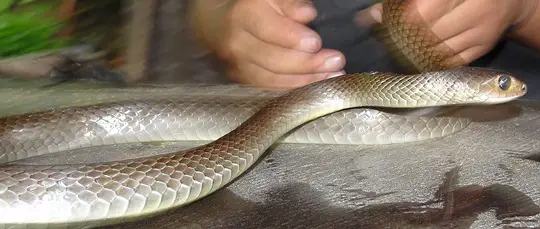
My Indochinese Rat Snake Photos:

Another photo, showing same snake but darker exposure. It looks more brown toward the tail:
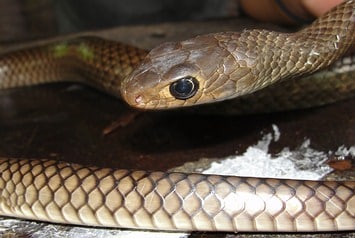
Indo-Chinese Rat Snake Video:
Juvenile Indo-Chinese Rat Snake Video
- Common Non-Venomous Snakes Post #1 Post #2
- Brahminy Blind Snake
- Brown Kukri Snake
- Copper-Headed Racer / Radiated Rat Snake | IndoChinese Rat Snake | Oriental Rat Snake / Banded | Red-Tailed Racer | Ridley’s Racer | White-Bellied Rat Snake
- Dragon Snake
- Laotian Wolf Snake
- Malayan Bridle Snake
- Orange-Bellied Snake
- Red-Tailed Pipe Snake
- Reticulated Python | Blood Python | Burmese Python
- Striped Bronzeback
- Sunbeam Snake

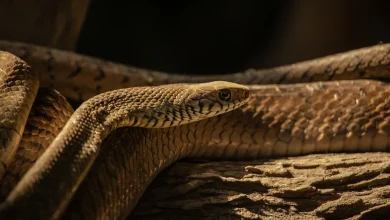
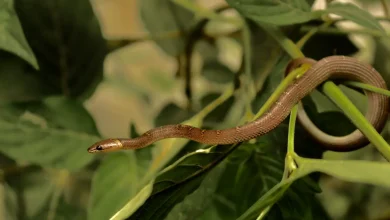
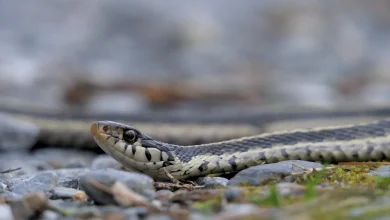
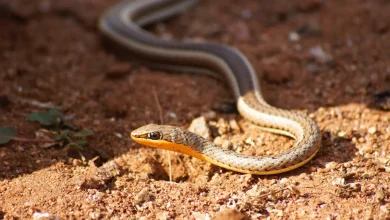
I’m living in north Thailand near Phayao,and teach at a sch0ol just below the mountains in the rice fields 20 kilomerters north of Phayao.
Saw one of these ratsnakes up close as it was completely exposed and almost completely stretched out on a sloping wall above a small trench on the school property during the noon hours of the day. It was easily five feet long, (certainly much more than just over one meter) so I’m assuming its a rather large one for its species
The Thais seem very afraid of snakes whether they are venomous or not. Thai teachers and about twenty five students were in awe and scared of it even though I tried to explain it wasn’t dangerous.
Had to keep the Thai boy students from throwing very small stones at it. I moved it to some brush and weedy cover where it easily disappeared from the Thais potential torture. It wasa a beautiful silvery grey color and the eyes looked kind of blue-grey.. a beautiful looking creature.
Hi Bill,
Yep, these can be some great looking snakes. Very strong, super fast. They have big eyes and cool looking heads. They are very aware of humans, and never really relax completely around us. Cheers, Vern
Cool website,
Our neigbours here in the north caught a big one , I was invited to taste it. Not bad, eh bit spicy tho